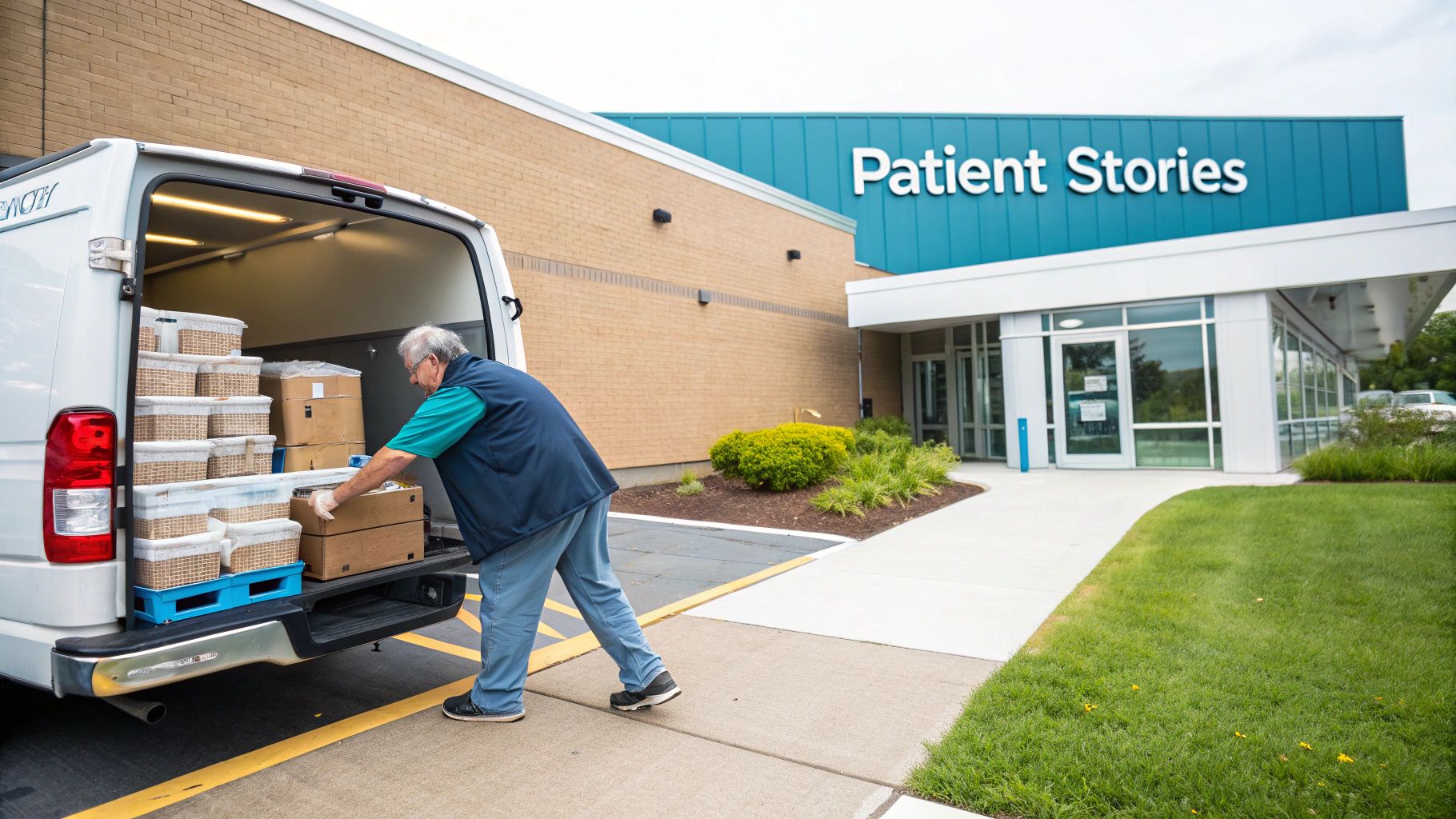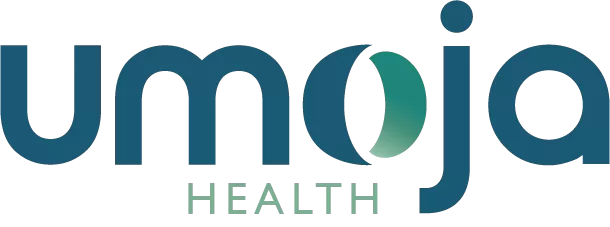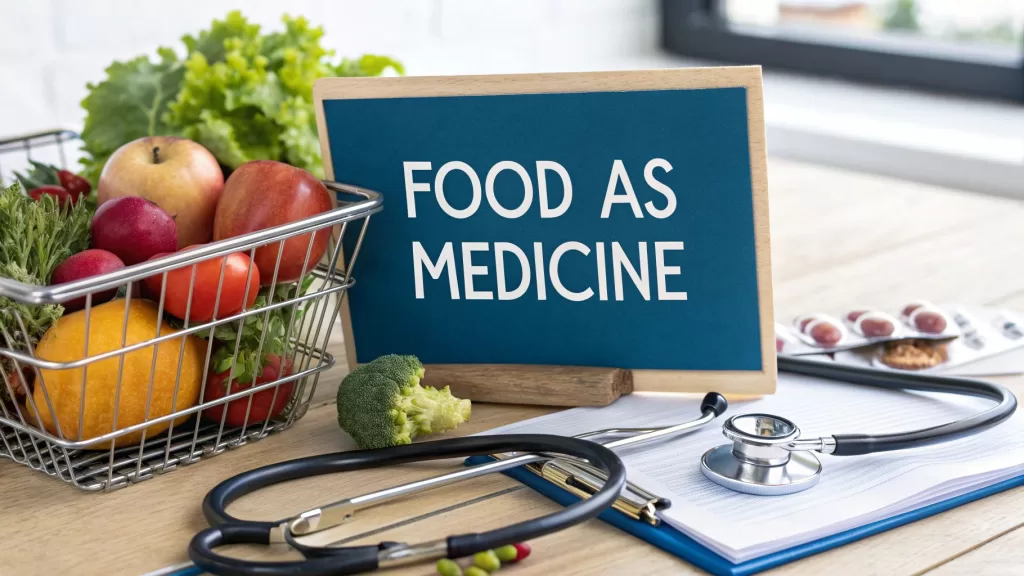Food as medicine is no longer a fringe concept; it’s an evidence-based clinical strategy reshaping healthcare from the inside out. As an expert review, this guide dives deep into the evolution of food as medicine healthcare programs, analyzing the policy shifts and payer-driven models that are catapulting nutrition from a wellness perk to a core medical intervention. At its heart, these programs leverage targeted nutrition—from medically tailored meals to produce prescriptions—to prevent, manage, and treat chronic disease.
The Evolution of Food as Medicine in Healthcare

Imagine a doctor writing a prescription filled in a grocery aisle instead of a pharmacy. This is the paradigm shift at the core of the ‘Food as Medicine’ (FIM) movement. It’s a strategy moving beyond symptom management to tackle the root causes of chronic illness head-on, using precise, targeted nutrition as a primary clinical tool.
What began as localized community pilots has evolved into a sophisticated ecosystem of structured, payer-funded models that are fundamentally changing patient care.
The momentum is undeniable. In the United States, the crisis fueled by poor nutrition is linked to over 600,000 deaths and a staggering $1.1 trillion in preventable healthcare costs and lost productivity annually. Confronted by these figures, health systems are finally integrating FIM interventions into standard care protocols.
From Niche Concept to Mainstream Strategy
For decades, the link between diet and health was acknowledged but siloed. Food was for prevention; medicine was for treatment. FIM programs have shattered that obsolete wall, making nutrition a prescribed, reimbursed, and critical component of a patient’s recovery and disease management plan.
The primary catalyst for this shift is the industry-wide pivot to value-based care. Payers and providers are now financially accountable for improving health outcomes and lowering total cost of care, not just billing for services. When you analyze the data behind lifestyle changes that truly work for heart disease, it’s evident that FIM programs are a powerful lever for hitting value-based targets, especially for patients with diet-sensitive conditions like diabetes, hypertension, and congestive heart failure.
To understand the landscape, it’s crucial to recognize the primary models. While variations exist, interventions generally fall into a few key categories.
Core Models of Food As Medicine Programs
| Program Model | Description | Ideal For Patients With… |
|---|---|---|
| Medically Tailored Meals (MTM) | Fully prepared meals delivered to a patient’s home, designed by a Registered Dietitian to meet the specific nutritional needs of their medical condition. | Complex chronic conditions (e.g., congestive heart failure, ESRD, diabetes) or those recently discharged from the hospital who have limited mobility or cooking ability. |
| Produce Prescriptions (PRx) | Prescriptions or vouchers for patients to obtain fresh fruits and vegetables from participating grocery stores or farmers’ markets. | A broader range of diet-sensitive conditions where the primary goal is to increase consumption of healthy foods and empower patient choice. Often paired with nutrition education. |
| Medically Tailored Groceries | A curated box of grocery items (produce, lean proteins, whole grains) selected to meet a patient’s dietary needs, allowing them to prepare their own meals. | Patients who are able and willing to cook but need guidance and access to the right ingredients. A good middle ground between MTM and PRx. |
Each model serves a distinct clinical purpose, enabling healthcare organizations to match the intervention’s intensity with the patient’s acuity and needs.
Umoja Commentary: Where Payers Are Moving
From our vantage point at Umoja, the most significant trend is the growing appetite from payers—Medicaid, Medicare Advantage, and commercial insurers—to invest in these programs. They are moving beyond simple wellness perks and are now actively sourcing scalable, data-driven solutions that deliver measurable clinical and financial ROI.
Payers have stopped viewing food as a social expense and now see it as a critical medical investment. The data is clear: providing a few hundred dollars’ worth of medically tailored groceries can prevent a ten-thousand-dollar hospital readmission. That simple math is fundamentally reshaping population health strategies nationwide.
This shift has profound implications. It signals an end to reliance on grant-funded pilots. The future lies in building compliant, logistically sophisticated food as medicine healthcare programs that meet stringent payer requirements for reimbursement and reporting. This is a call to action for innovation—demanding integrated workflows, robust data analytics, and scalable procurement to elevate nutrition to a true standard of care.
How Policy and Payer Strategies Are Igniting Growth
The explosive growth of food as medicine healthcare programs is no accident. It’s the direct result of a powerful convergence where progressive federal policy is finally aligning with the strategic imperatives of healthcare payers.
What were once small, grant-funded passion projects are rapidly becoming integrated, reimbursable components of mainstream healthcare. This evolution is being driven by a new landscape shaped by both government action and insurer strategy.
A critical catalyst has been key policy changes at the federal level. The Centers for Medicare & Medicaid Services (CMS) has opened the door for states to utilize Section 1115 waivers, granting them the flexibility to test innovative care delivery models that address health-related social needs.
States like North Carolina, California, and Massachusetts have seized this opportunity, launching pilot programs that explicitly cover nutrition services—including medically tailored meals and produce prescriptions—as a core benefit for Medicaid members.
This federal green light marks a seismic shift, empowering health plans to treat food as a legitimate, evidence-based medical intervention.
The Payer Pivot to Value-Based Care
From our perspective at Umoja, the single greatest driver is the healthcare payer community’s accelerated transition away from fee-for-service models. In a value-based world, payers are financially rewarded for keeping populations healthy, not for authorizing more procedures.
This is where food as medicine demonstrates its unique power.
Payers are now laser-focused on critical population health goals:
- Slashing hospital readmissions: Providing medically tailored meals to a post-discharge congestive heart failure patient can dramatically reduce the likelihood of a costly return to the hospital.
- Improving chronic condition management: For an individual with uncontrolled type 2 diabetes, a 12-week medically tailored grocery program can improve HbA1c levels more effectively and sustainably than medication alone.
- Driving health equity: These interventions directly address social determinants of health, such as food insecurity, that fuel stark health disparities.
Payers have moved past asking if these programs work. Now, they’re asking how to scale them efficiently and effectively. They’ve seen the data showing that a smart investment in healthy food can head off tens of thousands of dollars in downstream medical bills. That kind of ROI is getting impossible to ignore.
Financial Models That Make It All Work
Widespread adoption hinges on sustainable financial models. Payers are operationalizing several frameworks to reimburse for food as medicine healthcare programs, transitioning them from temporary pilots to permanent, contracted services.
One of the most promising models is treating nutrition services as an “in lieu of service” (ILOS). This framework allows a managed care plan to pay for a non-traditional service, like a produce prescription program, because it is a medically appropriate and more cost-effective substitute for a standard benefit, such as an emergency department visit. Programs like the Special Supplemental Nutrition Program for Women, Infants, and Children (WIC) have long demonstrated the power of connecting nutrition access with healthcare. You can learn more about how modern WIC programs are innovating at Umoja Health.
Payers are also weaving food as medicine into shared savings and capitated payment models. In a shared savings agreement, if a provider implements a FIM program that lowers the total cost of care, the payer shares a portion of those savings back with the provider, creating a powerful financial incentive to invest in nutrition.
This alignment of policy, payer incentives, and innovative financing is creating a tipping point. The challenge for healthcare leaders is no longer about proving the value of food as medicine—it’s about building the operational muscle to deliver these life-changing programs at scale.
A Practical Framework for Designing Your FIM Program
With the tailwinds of policy and payer support, the conversation has decisively shifted from why we should implement food as medicine programs to how. Launching a successful initiative requires a strategic framework that balances patient needs, operational realities, and payer requirements from day one.
A Framework for Health Systems: From Concept to Scale
For health systems looking to get started, we recommend a phased approach:
- Phase 1: Identify & Target
- Define Your Population: Begin with high-risk, high-cost patient groups where nutrition has a clear clinical impact. Prime examples include patients with congestive heart failure (CHF) to reduce readmissions, uncontrolled Type 2 diabetes to lower HbA1c, or end-stage renal disease (ESRD) for critical dietary management.
- Integrate Screening: Weave food insecurity and clinical screening questions directly into your EHR intake forms. Create automated flags for patients with specific diagnoses and poor clinical markers to streamline identification.
- Phase 2: Design & Partner
- Select the Right Intervention: Choose your model based on patient acuity and capability. Use medically tailored meals (MTM) for high-acuity, low-mobility patients post-discharge. Use medically tailored groceries (MTG) or produce prescriptions (PRx) for patients who can cook but need access and guidance. A hybrid approach is often most effective.
- Forge Strategic Partnerships: You don’t have to build the entire infrastructure yourself. Partner with specialized FIM vendors, community-based organizations, or food banks who have existing logistics, procurement, and community trust. This accelerates your launch and reduces initial capital expenditure.
- Phase 3: Execute & Operate
- Simplify Referral Workflows: The referral process must be frictionless. An ideal workflow is an integrated EHR order that requires minimal clicks from the clinician.
- Solve the Last Mile: Logistics are paramount. Determine your delivery strategy—whether through an in-house fleet, a local courier, or a specialized third-party logistics (3PL) partner who understands cold-chain compliance. Reliability is non-negotiable.
- Phase 4: Measure & Optimize
- Define Your KPIs: From the outset, track a balanced scorecard of clinical outcomes (HbA1c, blood pressure), financial metrics (readmission rates, total cost of care), and patient-reported outcomes (food security scores, satisfaction).
- Build Your ROI Case: Use this data to create a compelling narrative for payers and internal stakeholders, proving that your program is not a cost center but a value generator.
The evidence is clear: both MTM and MTG models work. A systematic review confirmed that ‘Food Is Medicine’ programs consistently boost diet quality and food security for people with chronic conditions. You can dig into the findings on how these programs improve dietary patterns in the American Heart Association’s newsroom.
The infographic below shows how all the pieces—policy, payment, and provider adoption—are coming together to fuel this movement.

As you can see, there’s a clear pathway where regulatory support gives payers the confidence to invest, which in turn helps providers adopt and scale these life-changing programs.
Navigating Logistics and Compliance
A brilliant program design is irrelevant without a rock-solid operational engine. The logistics of food as medicine healthcare programs are complex, covering everything from procurement and patient referral to last-mile delivery.
Key operational hurdles include:
- Patient Referral Workflows: How do clinicians enroll patients? Whether an EHR order or a partner portal, it must be simple and fast.
- Procurement and Kitting: Where will the food come from? How will you guarantee it meets strict dietary and quality standards? For MTG, how will you assemble grocery boxes safely and efficiently? Partnering with experts on food box kitting programs can de-risk this process.
- Last-Mile Delivery: This is often the most challenging piece. Reliability and temperature control are paramount, whether using your own drivers or a specialized 3PL partner.
Compliance runs parallel to logistics. If you’re using federal funds, provisions like the Buy American clause may apply. If your program overlaps with populations eligible for CACFP or SFSP, your nutritional guidelines must align. Building a program that is both clinically effective and audit-proof requires meticulous attention to these details from day one.
Measuring Success and Proving Program Impact
To permanently embed food as medicine healthcare programs into the standard of care, compelling patient stories must be backed by hard data. Proving a tangible return on investment (ROI) is essential to secure sustained funding and convince payers to make these programs a permanent, reimbursed benefit.
Success is measured by the ripple effect of nutrition, articulated through key performance indicators (KPIs) that resonate with healthcare payers and administrators. Your data must tell a clear story across three domains: clinical outcomes, financial impact, and patient-reported experience.
Clinical and Financial KPIs
For payers, the most persuasive evidence is a combination of improved health markers and reduced healthcare spending. Your reporting dashboard should visualize this cause-and-effect relationship directly.
Key clinical and financial KPIs to track include:
- Clinical Outcomes: Track direct health improvements like HbA1c levels, blood pressure, and BMI changes throughout the intervention.
- Healthcare Utilization: This is where savings become tangible. Monitor 30-day hospital readmission rates, emergency department visits, and total inpatient days for participants versus a control group.
- Total Cost of Care: The ultimate metric. Demonstrating a net reduction in per-member-per-month medical spend, even after accounting for program costs, is the gold standard of ROI.
A well-designed dashboard doesn’t just list data points; it tells a story. Visualizing a 1.5-point drop in average HbA1c right next to a 25% reduction in ER visits for the same group of patients makes your value impossible to ignore.
Patient-Reported Outcomes
Clinical and financial data tell only part of the story. Patient-reported outcomes (PROs) provide vital context, measuring the program’s impact on quality of life, well-being, and self-efficacy in managing health.
Important patient-reported metrics to measure:
- Food Security Status: Use a validated tool like the USDA’s 6-Item Short Form Food Security Survey to show a measurable improvement in food access.
- Patient Satisfaction: High satisfaction scores with food quality, delivery, and support are leading indicators of engagement and adherence.
- Medication Adherence: Ask participants if the program has made it easier to take their medications as prescribed.
- Self-Reported Health Status: Capture quality-of-life improvements through simple questions about energy levels, mental clarity, and ability to perform daily activities.
By weaving these three data streams together—clinical, financial, and patient-reported—you build an undeniable case for your program’s impact. This is how you transition from a “pilot project” to an indispensable component of modern healthcare.
Real-World Examples of Food as Medicine Programs in Action

The real power of food as medicine healthcare programs emerges in their real-world application. These brief case studies illustrate how different organizations are tackling specific health challenges with targeted nutrition, highlighting common hurdles, creative solutions, and measurable results.
Medicaid Plan Tackles Prediabetes with Produce Prescriptions
The Challenge: A state Medicaid plan identified a surge in members with prediabetes, many living in food deserts. They needed a scalable intervention to prevent progression to costly Type 2 diabetes.
The Solution: The plan launched a 16-week produce prescription (PRx) pilot, partnering with a major grocery chain. Enrolled members received a $60 monthly stipend on a restricted-spend debit card for fresh fruits and vegetables, supplemented with virtual nutrition counseling and text-based recipe support.
The Outcome: The results were compelling: a 22% increase in fruit and vegetable consumption and, critically, 45% of participants showed improvements in key biometric markers like fasting glucose. The successful pilot secured funding for a statewide expansion.
This example demonstrates that empowering patient choice can be as potent as providing pre-selected meals. By giving members the tools and resources to make healthier decisions, the plan fostered sustainable habits.
A WIC Pilot Supports High-Risk Postpartum Mothers
The Challenge: A local WIC agency targeted postpartum mothers with gestational diabetes and hypertension, a group at high risk for developing chronic conditions who struggled with the time and knowledge to eat healthily.
The Solution: The agency launched a 12-week medically tailored grocery (MTG) pilot. Participants received a weekly box of heart-healthy, low-glycemic ingredients—lean proteins, whole grains, fresh produce—and simple 30-minute recipes delivered to their homes.
The Outcome: The program achieved a 95% participant satisfaction rate. Clinically, 60% of mothers with hypertension saw their blood pressure normalize. The initiative proved the value of convenient, targeted support during a critical life transition.
Hospital and Food Bank Partner on Post-Discharge Meals
The Challenge: A large urban hospital struggled with high 30-day readmission rates for patients with congestive heart failure (CHF), finding that many failed to adhere to low-sodium diets at home due to fatigue, confusion, or food insecurity.
The Solution: The hospital partnered with a local food bank with a commercial kitchen to create a medically tailored meal (MTM) program. Discharged CHF patients received a two-week supply of frozen, low-sodium meals. The food bank’s dietitians worked directly with hospital clinicians to ensure every meal met precise nutritional standards.
The Outcome: This collaboration drove a 38% reduction in CHF readmissions within the first year, demonstrating a highly cost-effective model that transformed the food bank into an extension of the hospital’s clinical care team.
The Future of Nutrition in Healthcare: A Call to Action for Innovation
The evidence is in. The pilots have proven their value. The momentum is undeniable. The next great challenge for food as medicine healthcare programs is to scale, moving from isolated successes to a fully integrated standard of patient care. This is a forward-looking call to action for healthcare leaders to embrace nutrition as a core clinical strategy.
The economic imperative is staggering. Research indicates that providing medically tailored meals to just 6.3 million Americans with diet-related conditions could prevent an estimated 1.6 million hospitalizations, generating a net savings of $13.6 billion in healthcare costs in the first year alone. You can explore the cost-effectiveness of these programs to grasp the powerful return on these models.
The Next Frontier: Technology and Innovation
Technology will be the great accelerator. The future is AI-driven personalization, where nutrition plans adapt in real-time to a patient’s biometric data—imagine a grocery order that automatically adjusts based on a user’s latest blood sugar reading.
Simultaneously, innovations in logistics, supply chain management, and the emerging Foodpharma sector advancements will make these programs more efficient and scalable. Optimized delivery routes, predictive inventory management, and sophisticated kitting operations will lower costs and ensure the right food reaches the right person at the right time.
Umoja Commentary: Where Payers Are Moving
From what we’re seeing, payers are rapidly shifting their focus from short-term cost containment to long-term value and health equity. They’re no longer just funding 12-week pilots. They’re looking for partners who can deliver multi-year, data-driven programs that measurably reduce the total cost of care and improve HEDIS scores. The future is in scalable, compliant platforms that can manage diverse populations and provide robust, transparent reporting that proves impact.
A Concluding Call for Innovation
The foundation has been laid by pioneers in policy, healthcare, and community service. The data is clear, the financial models are maturing, and the need has never been greater. The challenge now is one of imagination and execution. It is time for health systems, payers, and innovators to move beyond the pilot phase and commit to building the infrastructure, partnerships, and technologies needed to permanently weave food as medicine into the fabric of American healthcare. The future of a more effective, equitable, and sustainable health system depends on it.
Got Questions? We Have Answers.
Let’s dig into some of the most common questions we hear about getting food as medicine programs off the ground. These are the practical, real-world answers that can help healthcare providers, health plans, and community leaders figure out their next steps.
How Do Patients Actually Qualify for These Services?
It’s usually a combination of two key things: a clinical diagnosis and a social need. Most programs are designed for folks managing specific diet-sensitive chronic conditions—think congestive heart failure, uncontrolled type 2 diabetes, or end-stage renal disease.
But a diagnosis is only half the story. Programs also screen for social factors, with the big one being food insecurity. A patient typically gets the green light if they have a relevant medical condition and they don’t have consistent access to healthy food. This two-part check ensures that the resources get to the people who need them most and where they’ll make the biggest difference.
What Does a Typical Program Look Like from Start to Finish?
From the moment a patient is identified to the last meal delivery, the process follows a pretty clear path. It usually breaks down into five stages:
- Screening and Referral: It starts with a clinician. They might spot an eligible patient through their electronic health record or a quick screening questionnaire. From there, they place a “prescription” or referral for a specific food program.
- Onboarding: Next, a program coordinator reaches out to the patient. This is a crucial step where they explain how it all works, confirm any dietary needs or allergies, and get the delivery schedule locked in.
- The Intervention: This is the core of the program. For a set period, often 12 to 16 weeks, the patient receives their medically tailored meals, grocery boxes, or produce prescriptions delivered right to their door.
- Education and Support: It’s not just about the food. During the program, patients usually get nutrition education, healthy recipes, or simple check-in calls to help them build lasting habits.
- Transitioning Out: When the program wraps up, the goal is to create a soft landing. The care team helps connect the patient with long-term community resources, like SNAP or local food pantries, to help them keep up their progress.
How Can We Start Building the Right Community Partnerships?
Strong partnerships are everything in this work. The best place to start is by mapping out the key players in your local food world. Think about your area’s food banks, Meals on Wheels chapters, or other community organizations that are already connected with the patients you want to serve.
Don’t try to boil the ocean. Start with a small, well-defined pilot project. You could propose a partnership to serve a very specific group, like post-discharge heart failure patients. This lets you demonstrate value and build trust. A successful pilot gives you a powerful story to tell when it’s time to secure bigger, more sustainable funding.
Ready to build a compliant, scalable, and culturally connected food as medicine program? Umoja Health provides the food, logistics, and expertise to help health plans, food banks, and government agencies deliver impactful nutrition interventions nationwide. Learn more at https://umojahealth.com.

